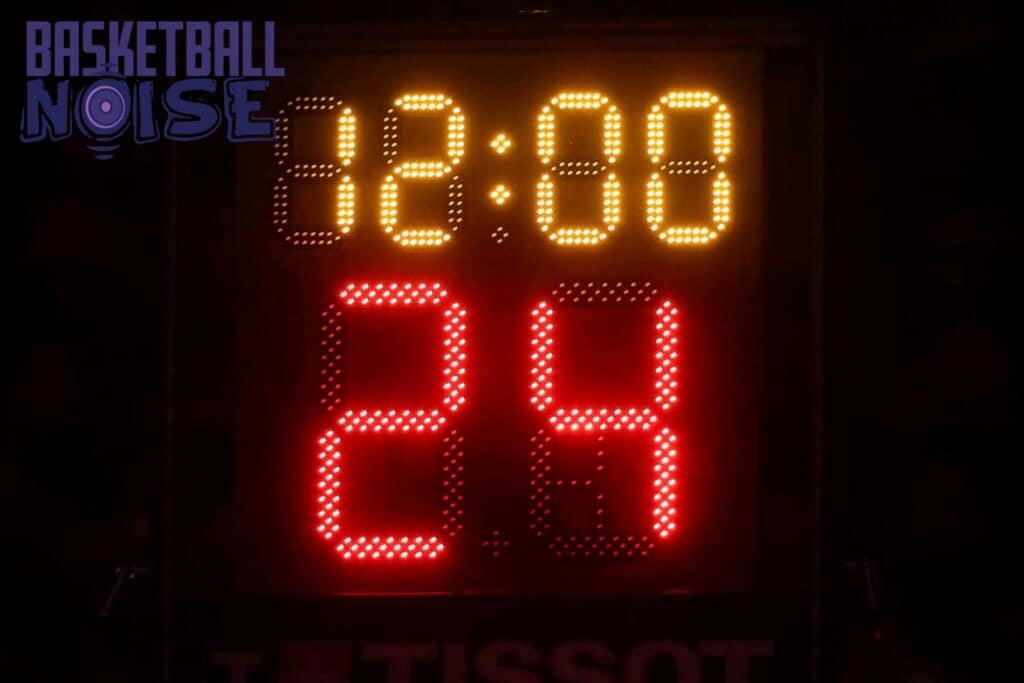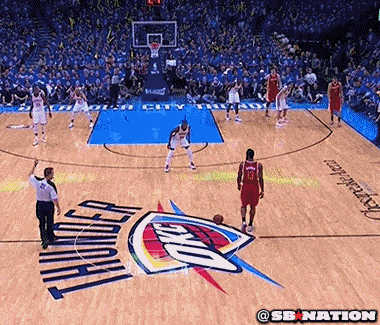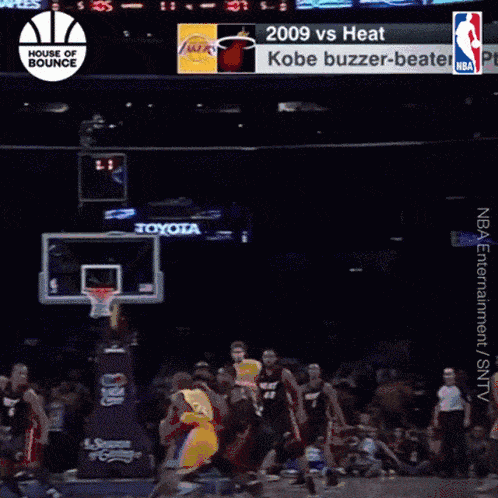A 48 minute NBA game is broken up into 4 quarters of 12 minutes. Between the 1st and 2nd quarter a 2 minute 30 second break is mandated. After the 2nd quarter the teams observe a 15 minute half time before play resumes for the 3rd quarter. Between the 3rd and 4th quarter a 2 minute 30 second break is mandated. If the game is tied after the final buzzer in the 4th quarter, subsequent periods of 5 minute overtime will be played following a 2 minute 30 second break until a period ends with one team in the lead. Each team has 7 timeouts they can use during play. The first time out for a team in each period lasts 2 minutes 45 seconds, subsequent time outs last 1 minute 15 seconds. During nationally televised games time outs and end of quarter breaks are longer.

We dive into the specifics of how an NBA game is broken up below. Looking at when the clock starts and stops, how long breaks in play are, how time outs work, what is a coach’s challenge and more.
The minimum amount of time an NBA game can last is broken down below:

The table above only takes into account the events that have a specific measurement of time. There are other situations, such as the Officials reviews, free throws and the time it takes players to get the ball back into play from dead ball situations where the game clock is stopped and that time cannot be consistently calculated. A good estimation is that for the average NBA game another 45 mins of “dead ball” time should be added, bringing the real time duration of an average NBA game to about two and a half hours.
All the official timing rules for the upcoming NBA season can be found by following this link, however we have summarized below, so you don’t have to! First we’ll look at when the game clock starts and stops.
When does an NBA game clock start and stop?
An NBA game clock will start running after any dead ball situation (including opening tip) as soon as the ball touches a player. You may have seen NBA players walking up to the court next to a rolling ball, this is a tactic used to delay the start of the clock and progress the ball down court without losing precious seconds from the clock, or to circumvent the 8 second rule which requires a team to advance to ball past the halfway line within 8 seconds.

The game clock will not start until a player touches the ball.
The game clock stops whenever the official’s whistle sounds to stop the game. Other times the clock will stop, when the whistle doesn’t sound are:
- During the last minute of the1st, 2nd and 3rd periods following a successful field goal attempt.
- During the last two minutes of the 4th period and the last two minutes of any over time period.
At all other times the NBA game clock will be stopped between the whistle sounding and it touching a player on court.
How does a 48 minute NBA game break down into quarters?
All periods of regulation play in the NBA will be twelve minutes, all overtime periods of play will be five minutes. This means 4 x 12 minute quarters are played per game, if the score is tied as the final buzzer sounds additional 5 minute periods of overtime are played until there is a winner.
There is a Fifteen minute break between the two halves of games, taking place between the 2nd and 3rd quarter. This remains the same whether the game is a local or national broadcast. However the smaller breaks in between the 1st & 2nd and 3rd & 4th quarters are extended for national TV broadcasts.
“2:30 will be permitted between the first and second periods, the third and fourth periods and before any overtime period during local games. For national TV games 3:30 will be permitted between the first and second periods, the third and fourth periods and 2:30 before any overtime period.”
The above quote is taken directly from the NBA rules. This shows just how tied into the entertainment business the NBA is, adjusting game timings to allow for better TV broadcasting.
When does an NBA period end?
Each period ends when time expires on the game clock, however there are some exceptions and these are where the real drama of the NBA lives!
If a field goal attempt is in flight toward the basket, the period ends when the goal is made, missed or touched by an offensive player. See example below… Kobe!

Kobe being Kobe. RIP #24
If there is a foul committed while the buzzer sounds to signal the end of a period, it will not end until after the foul is penalized, this means a personal foul being awarded and any free throws being taken.
How does Overtime work in the NBA?
If the score is tied at the end of the 4th quarter, play shall resume after a 2:30 break, without the teams changing ends. This is the same no matter how many subsequent periods of overtime are required. Possession will start with a jump ball in the center circle for each required period of overtime. Overtime lasts for 5 minutes for every required period until one team leads at the end.
How do NBA timeouts work?
NBA timeouts are more complicated than they probably need to be. Each team has 7 timeouts that can be used during a regulation 48 minute NBA game. They can be used “whenever” they want, with the following caveats:
There must be two timeouts taken in each period. These are known as mandatory time outs. If neither team has taken a timeout prior to 6:59 of the period, the Official Scorer will call a timeout at the next dead ball and charge it to the home team. If no subsequent timeouts are taken prior to 2:59, the Official Scorer will call a timeout at the next dead ball and charge it to the team not previously charged. There is no requirement for both teams to have used a timeout in each period of play. One team could call both timeouts, or one could be charged as a mandatory timeout to the home team and that same team may also take a second time out, negating the need for a mandatory time out.
Mandatory timeouts won’t always be required. As long as 2 time outs are taken organically within the flow of the quarter by either side.
A request for a timeout by a player in the game or the head coach shall be granted only when the ball is dead or in control of a player on the team making the request. A player will not be granted a timeout if both feet are in the air and any part of his body has broken the vertical plane of the boundary line. This rule also applies to the midcourt line except during throw-ins in the last two minutes of the fourth or last two minutes of any overtime period.
Each team is limited to no more than 4 timeouts in the fourth period.
Each team will be limited to 2 timeouts after the later of;
(i) the three-minute mark of the fourth period or
(ii) the conclusion of the second mandatory timeout of the fourth period.
In overtime periods, each team shall be allowed 2 timeouts.
The NBA rules state the below;
Mandatory timeouts shall be 2:45 for local games and 3:15 for national games. Any additional team timeouts in a period beyond those which are mandatory shall be 1:15.
What this really means is that the first 2 timeouts taken in any period will last 2:45 (3:15 for National games) and any subsequent time outs will be 1:15 in duration. It does not matter if they were called by a coach or if the Official Scorer called them as a Mandatory time out.
If a request for a timeout in excess of those available to the team is made it shall be granted and a technical foul shall be called following the timeout, the ball will be awarded to the opposing team and play shall resume with a throw-in nearest the spot where play was interrupted after the technical free throw is taken.
